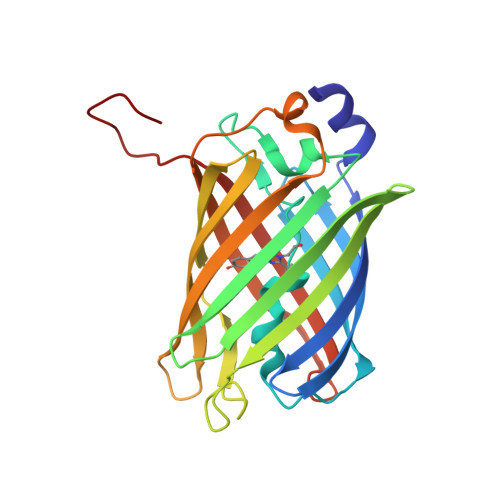Molecular Mechanism of a Green-Shifted, pH-Dependent Red Fluorescent Protein mKate Variant.
Wang, Q., Byrnes, L.J., Shui, B., Rohrig, U.F., Singh, A., Chudakov, D.M., Lukyanov, S., Zipfel, W.R., Kotlikoff, M.I., Sondermann, H.(2011) PLoS One 6: e23513-e23513
- PubMed: 21887263
- DOI: https://doi.org/10.1371/journal.pone.0023513
- Primary Citation of Related Structures:
3SVN, 3SVO, 3SVR, 3SVS, 3SVU - PubMed Abstract:
Fluorescent proteins that can switch between distinct colors have contributed significantly to modern biomedical imaging technologies and molecular cell biology. Here we report the identification and biochemical analysis of a green-shifted red fluorescent protein variant GmKate, produced by the introduction of two mutations into mKate. Although the mutations decrease the overall brightness of the protein, GmKate is subject to pH-dependent, reversible green-to-red color conversion. At physiological pH, GmKate absorbs blue light (445 nm) and emits green fluorescence (525 nm). At pH above 9.0, GmKate absorbs 598 nm light and emits 646 nm, far-red fluorescence, similar to its sequence homolog mNeptune. Based on optical spectra and crystal structures of GmKate in its green and red states, the reversible color transition is attributed to the different protonation states of the cis-chromophore, an interpretation that was confirmed by quantum chemical calculations. Crystal structures reveal potential hydrogen bond networks around the chromophore that may facilitate the protonation switch, and indicate a molecular basis for the unusual bathochromic shift observed at high pH. This study provides mechanistic insights into the color tuning of mKate variants, which may aid the development of green-to-red color-convertible fluorescent sensors, and suggests GmKate as a prototype of genetically encoded pH sensors for biological studies.
Organizational Affiliation:
Department of Molecular Medicine, College of Veterinary Medicine, Cornell University, Ithaca, New York, United States of America. qwang@berkeley.edy















